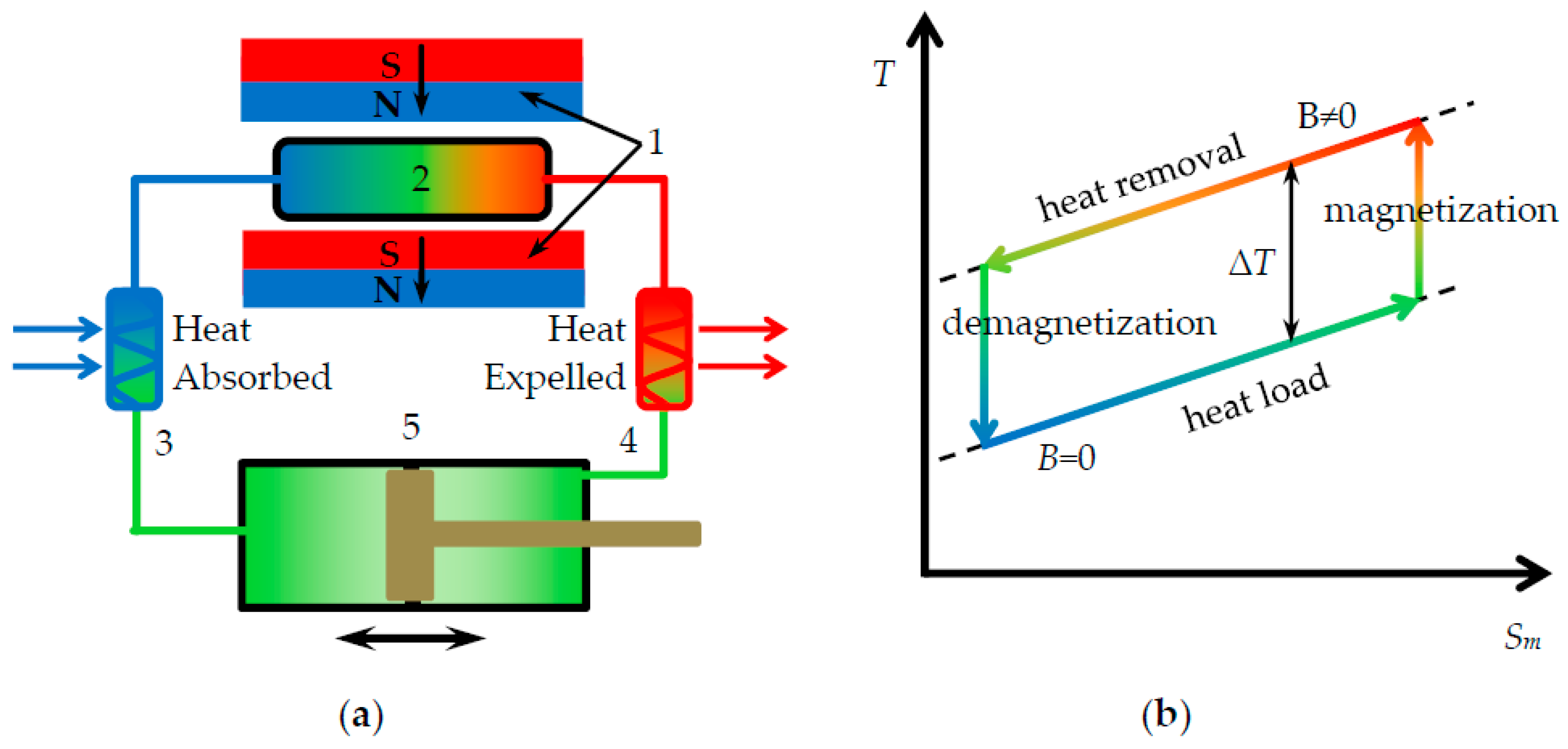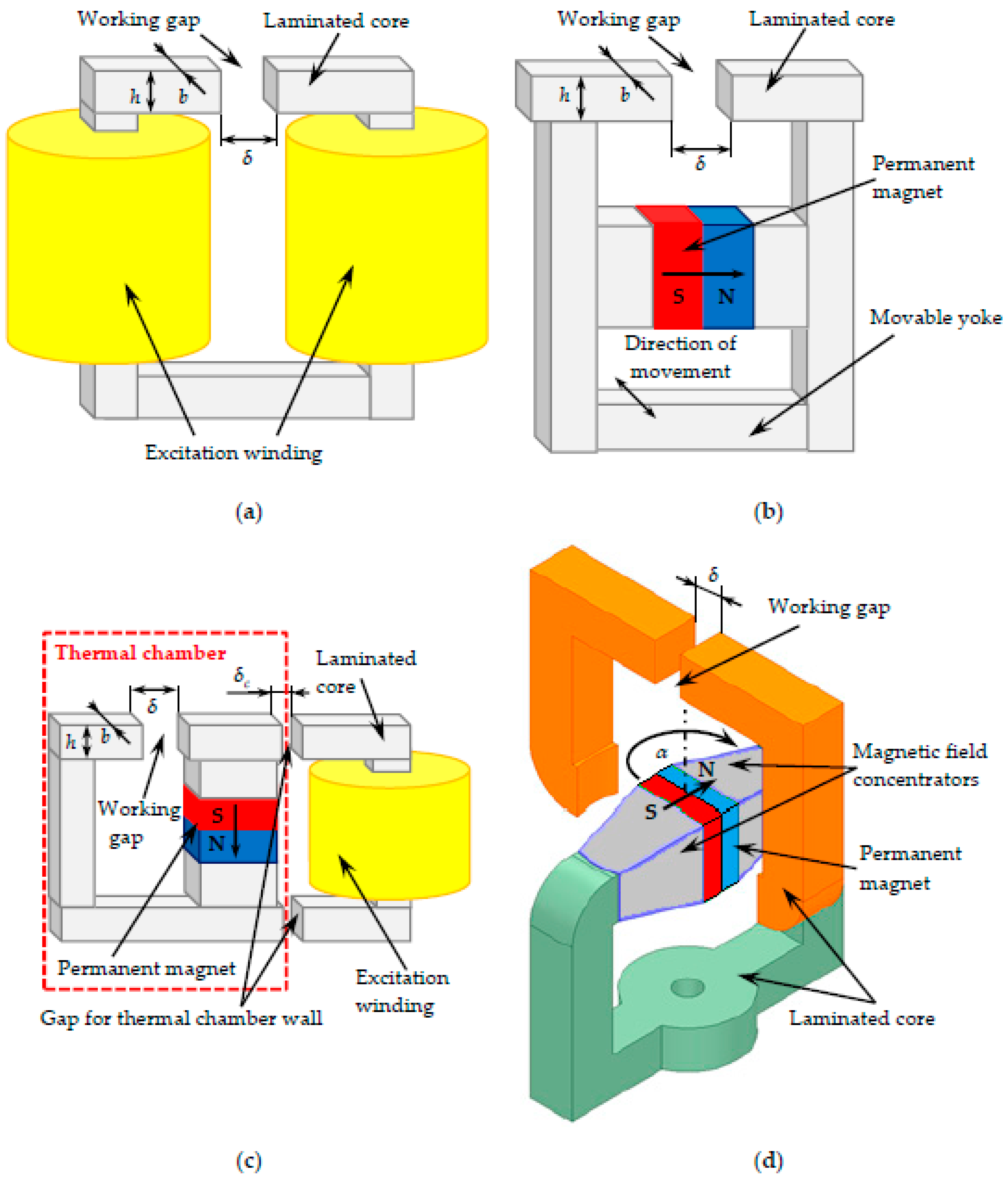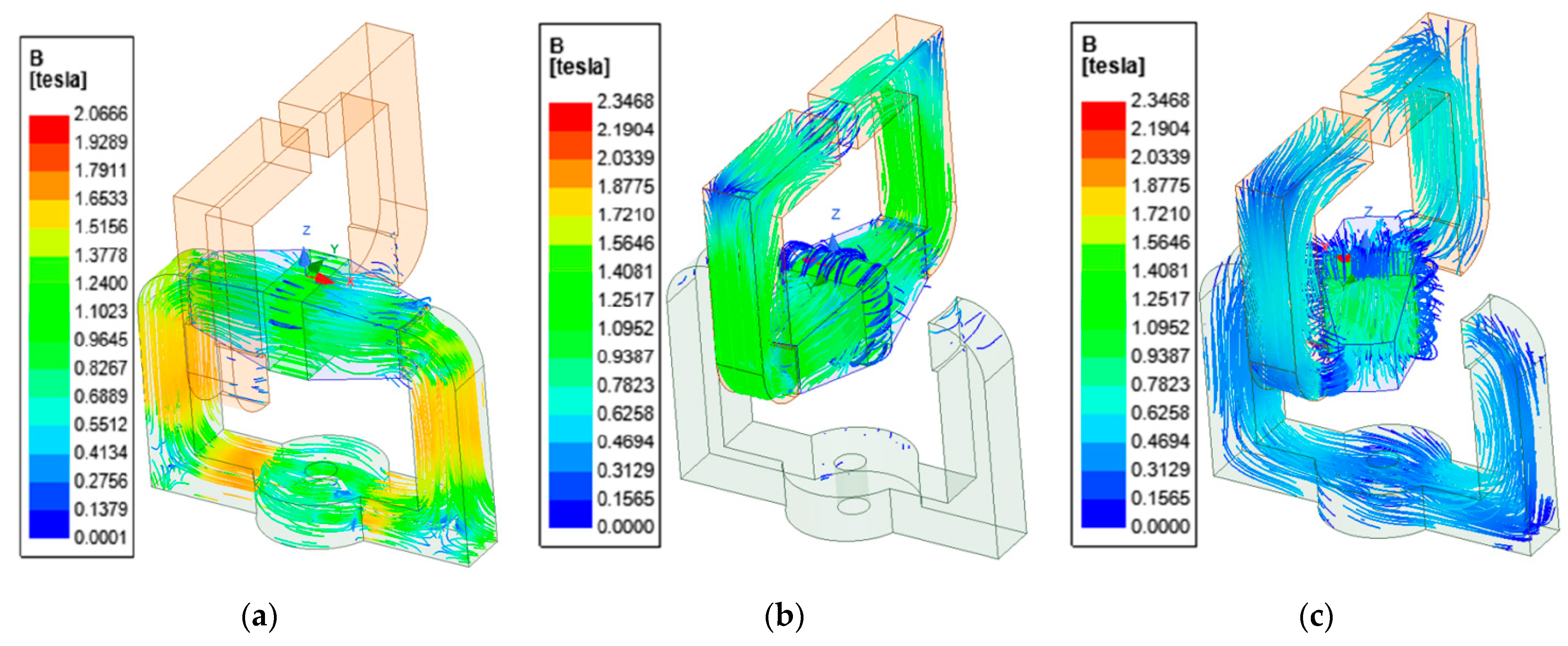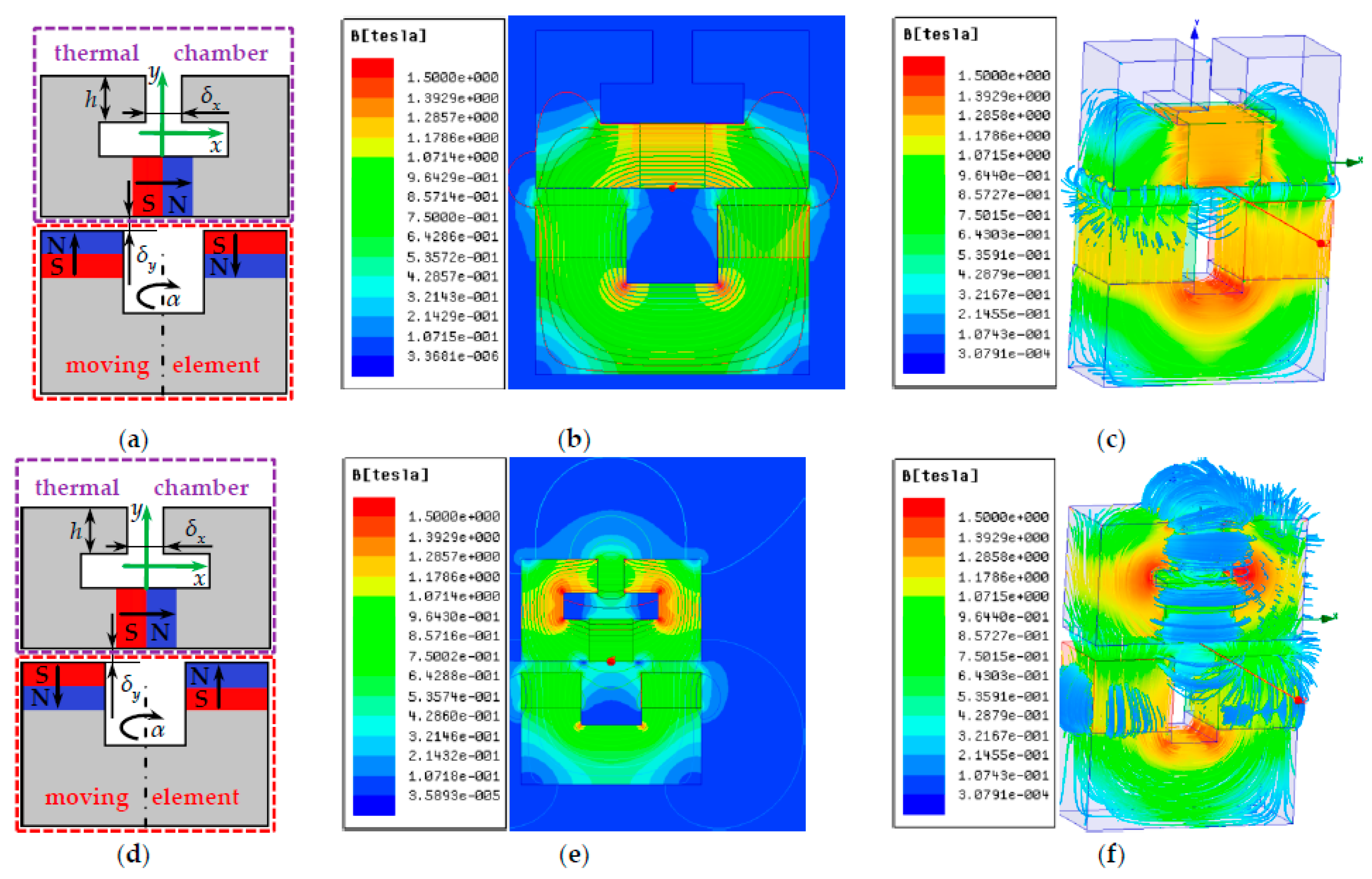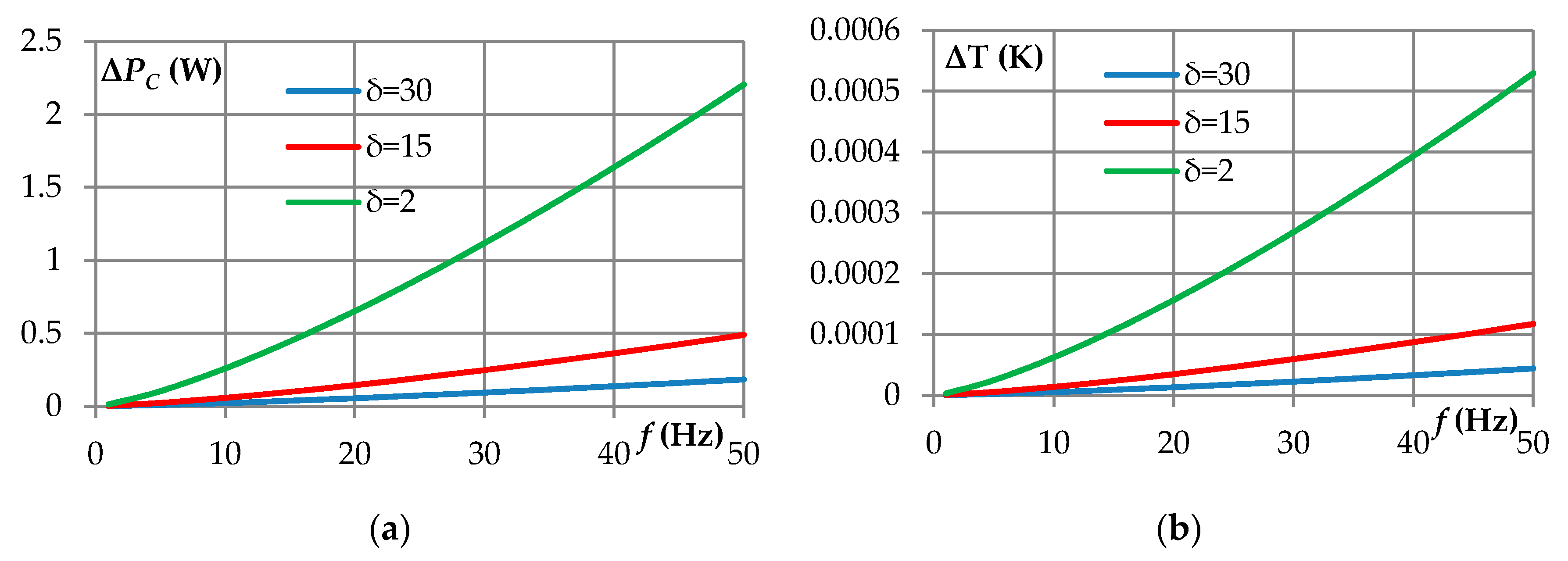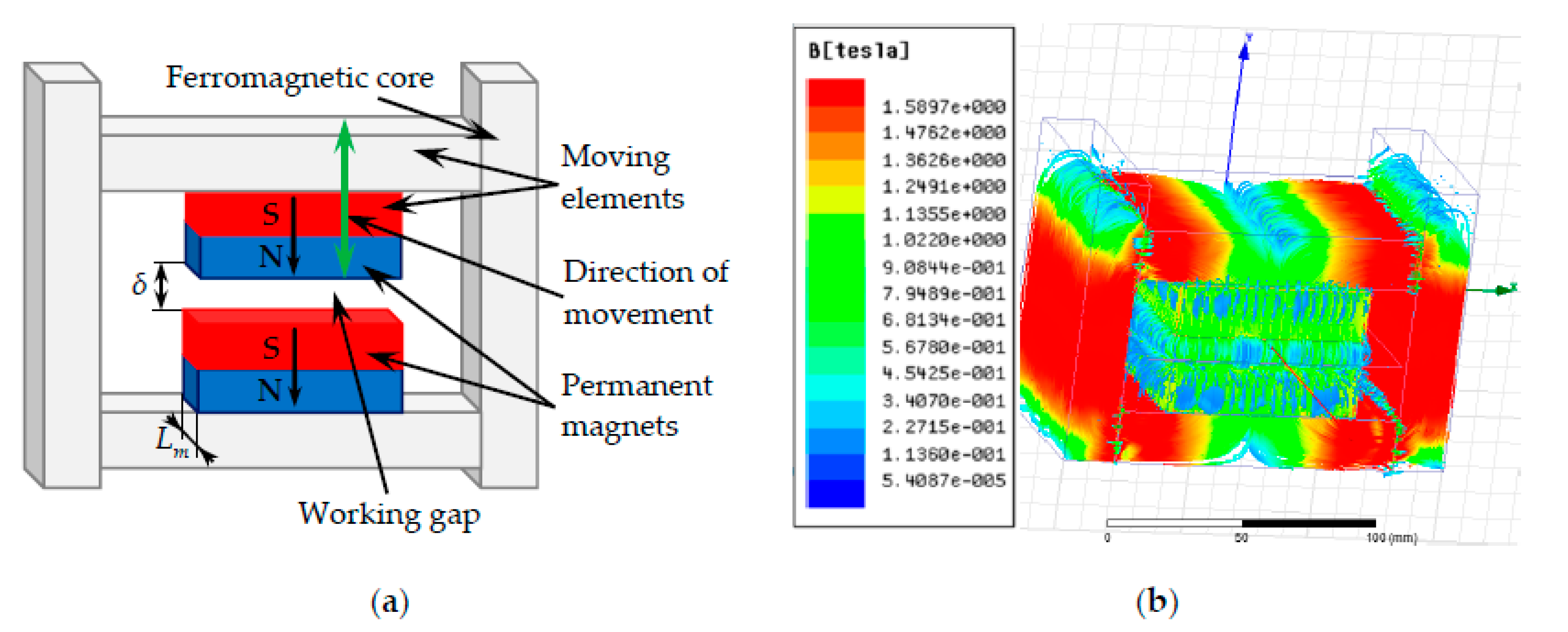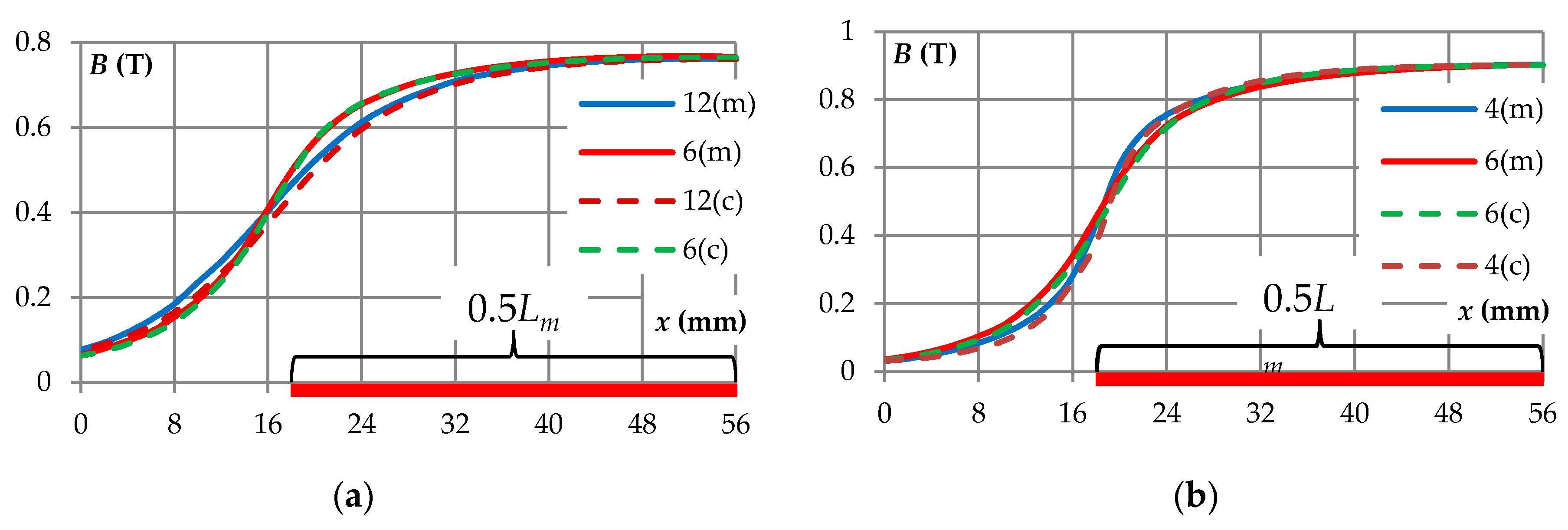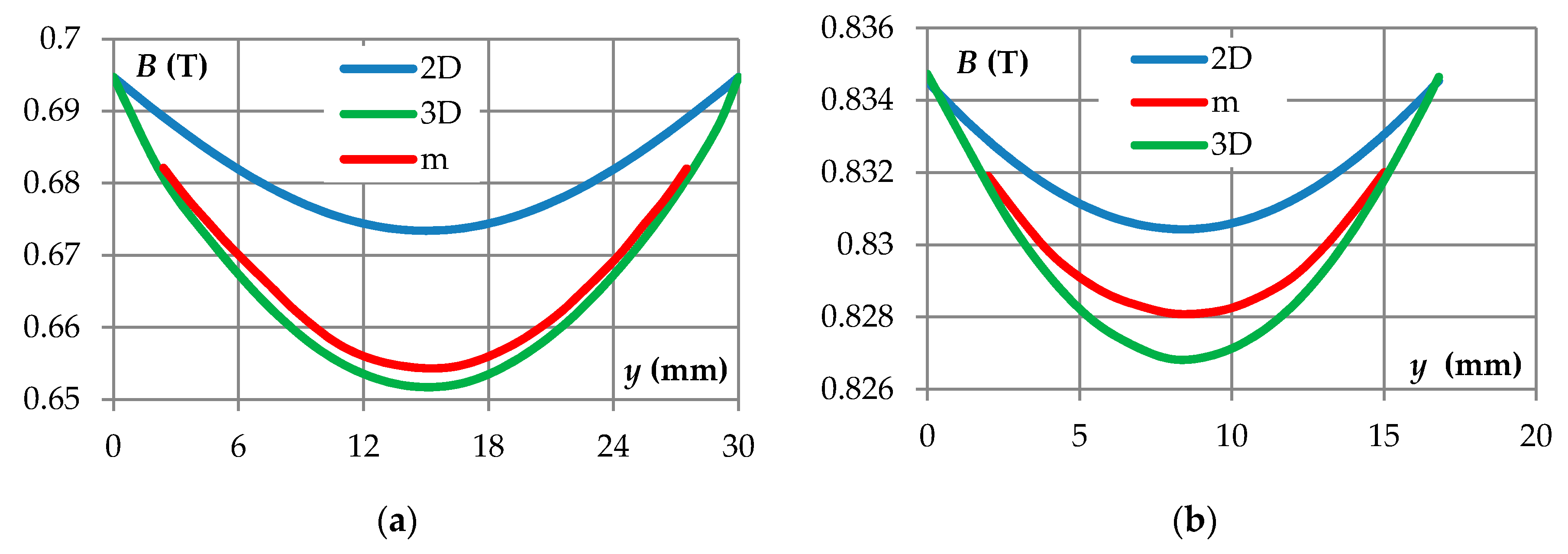1. Introduction
The experimental observation of the magnetocaloric effect (MCE) has usually been attributed to Emil Gabriel Warburg [
1,
2,
3], who noticed in 1881 that the iron sample heats up by several mK when placed in the magnetic field and cools down when the sample is removed from the magnetic field. However, in 2013 A. Smith [
4] indicated the key role of the experiments carried out in 1917 by P. Weiss and A. Picard [
5]. The physical background for the MCE was given by P. Debye in 1926 [
6] and W.F. Giauque in 1927 [
7].
The magnetocaloric effect is related to the change of entropy, ∆
Sm, and occurs in all magnetic materials. The MCE is most pronounced at the material-specific Curie temperature (
TC). Initially, the MCE was used mainly in laboratories to obtain very low temperatures, even below 1 K [
8]. The first magnetic heat pump operating at room temperature was built in 1976 [
9]. In the cooling system’s MCM, gadolinium with a Curie temperature
TC of 293 K was used. The change in the magnetic flux density ∆
B by 7 T was achieved by superconducting electromagnets which at this temperature caused a heat emission of 4 kJ/kg under isothermal conditions or an increase in temperature by ∆
Tad = 14 K under adiabatic conditions. A breakthrough event was the 1997 discovery of a giant magnetocaloric effect in the Gd
5Ge
2Si
2 alloy [
10]. This material exhibits the change in magnetic entropy that is more than twice as high as in gadolinium. The discovery of Gd
5Ge
2Si
2 properties stimulated the search for new MCMs and led to the discovery of other alloys exhibiting giant MCEs, e.g., MnAsSb [
11], NiMnGa [
12], and LaFeSi [
13]. However, these materials exhibit the MCE over a narrow temperature range which makes it difficult to develop functional magnetic refrigeration systems. For this reason, intensive research is being conducted to develop better and better MCMs (with higher entropy and a wider range of temperature changes) [
14,
15,
16,
17]. Currently, the hybrid MCMs are seen as a potential solution enabling the development of effective magnetic refrigeration systems [
18,
19,
20]. The inverse MCE has been observed as well in antiferromagnets and ferrimagnets like MnBr
4H
2O, Yb
3Fe
5O
12, Ni
50Mn
34In
16, CoMnSi, and Mn
1.82V
0.18Sb [
21]. There are also works on MCMs based on rare earth elements such as Gd, Dy, and Ho, for which the magnetocaloric effect occurs at cryogenic temperatures. The results of studies of these materials presented in [
22,
23] show that materials containing Gd are characterized by a relatively high magnetocaloric effect. The potential possibilities of using these materials in cryogenic magnetic cooling techniques have also been pointed out.
As already mentioned, the unique properties of MCMs can be applied for developing magnetic refrigeration systems. During a design process of such systems it is important to select the MCM properties that fit the specific technical solution of the magnetic cooling system. MCMs applied in cooling systems should have: an appropriate Curie temperature, wide range and low hysteresis of the MCE, high thermal conductivity, electric diffusivity and resistivity, corrosion resistance, invariability of magnetocaloric parameters over time, and a low production cost [
24]. The magnetocaloric properties of the selected MCMs at temperatures near room temperature [
24] have been summarized in
Table 1.
Intensive research on technical applications of the MCE is conducted [
24,
25,
26,
27,
28,
29,
30,
31,
32,
33] in many scientific and industrial research centers all over the world. Most of the applications of MCMs are related to cooling systems with an Active Magnetic Regenerator (AMR) [
29]. MCM in an AMR is utilized as a temperature-changing refrigerant during magnetization and demagnetization processes, as well as a regenerator for the heat carrier. A typical AMR based refrigerator (
Figure 1a) consists of: a magnetic field exciter (magnet or an electromagnet), a regenerator with MCM, hot and cold heat exchangers, a piston pump or other device ensuring the movement of the heat transfer fluid in both directions (to cold and heat exchangers) through the regenerator. The AMR work cycle includes adiabatic magnetization, and the demagnetization of MCM coincides with the flow of the heat carrier through the MCM regenerator without changing the magnetic field by the cold and hot exchangers [
24,
32]. The AMR operation is carried out in four steps as illustrated in
Figure 1b: 1—MCM magnetization (temperature increase), 2—extraction of heat (cooling), 3—MCM demagnetization (temperature decrease), 4—injection of heat (heating) [
24,
32,
33].
The characteristics of the MCE provided by MCM manufactures describe only the maximum temperature change of MCM for a given values of temperature and magnetic flux density [
34]. During the operation of an AMR the change of MCM temperature depends on both the magnetic field value and the MCM temperature. In other words, the MCM parameters and characteristics provided by the manufacturers are not sufficient for the detailed analysis and design of magnetic refrigeration systems. In order to properly design such a device, among others, the dependence of heat capacity on the value of the magnetic field and MCM temperature must be known. Some commercially available MCM datasheets show the dependence of specific heat on temperature, however, the data are limited to the behavior of the MCM at a zero magnetic field only. The reason for the lack of detailed data on the changes of specific heat under the influence of the magnetic field is the fact that the devices measuring the specific heat as a function of temperature in the presence of an adjustable magnetic field are unavailable on the market. The main methods of MCE measurements are presented and discussed in detail in
Section 2.
An important advantage of magnetic refrigeration technology is the elimination of environmentally harmful refrigerants used in traditional compressor systems. Moreover, cooling systems based on MCM are much more efficient than the currently used design solutions. As a result, the implementation of magnetic refrigeration technology will reduce the emission of greenhouse gases and electricity consumption. These factors motivate, on the one hand, intensive research to develop new magnetocaloric materials and, on the other hand, to develop reliable, energy-efficient magnetic cooling systems. A key aspect of both trends in these research studies is the need for accurate methods to measure the magnetocaloric effect.
The motivation to build low-cost systems for testing room temperature MCMs is the lack of such compact and low-cost systems on the market. For these reasons, the research presented in this paper has focused on the development of a dedicated field exciter. the test rig for measuring the properties of MCM. The presented paper proposes new designs of exciters and the employment of the professional finite element method (FEM) package to develop a 3D field model of electromagnetic phenomena to analyze properties of the exciters. The obtained results of the calculations of the magnetic field distribution in the working area are compared with the results of the measurements carried out on the exciter prototype.
First, in
Section 2 we briefly described the basic methods of MCE measurements to explain the requirements regarding magnetic field exciters and then
Section 3 presents the results related to design process of dedicated exciters of the magnetic field of systems for testing room temperature MCMs.
2. Methods of Measurement of MCE
The MCE can be described either by the isothermal change of magnetic entropy, ∆
Sm, or the adiabatic temperature change ∆
Tad. In general, there are direct or indirect methods of measuring the MCE [
35,
36,
37,
38,
39,
40,
41,
42,
43].
The indirect method enables the determination of the value of the change in ∆
Sm, on the basis of experimentally measured magnetization as a function of temperature for selected values of the magnetic field. The commercially available devices for magnetization and specific heat measurements are most often used for indirect MCE measurements. The change in entropy of an MCM material can be determined using thermodynamic Maxwell equations as [
33,
44]:
The following formula is preferred in the experimental calculation of ∆
Sm:
where
Mk and
Mk+1 are the values of the MCM magnetization of the sample in the magnetic field
Hk, respectively, at the temperatures
Tk and
Tk+1. The accuracy of the ∆
Sm estimation in this method is in the range of 20–30%.
The adiabatic temperature change ∆
Tad can be determined from combined
M(
T,
H) and specific heat
Cp,H measurements, according to the equation:
The determination of the MCE by measuring the magnetization
M and the specific heat
Cp,H is fairly easy. The calculation error ∆
Sm(
T,∆
H) depends on the accuracy of the measurements of the magnetization
M, specific heat
Cp,H, temperature
T, and magnetic field
H. This method is characterized by the high sensitivity of ∆
Sm(
T,∆
H) to changes in measurement data
M(
T,H) and
Cp,H. For example, when measuring the magnetization (using a SQUID magnetometer) with an accuracy of 0.5%, the calculation error ∆
Sm(
T,∆
H) is close to 7.5% [
45,
46].
The direct methods are based on measuring the MCM sample temperature upon the change of the external magnetic field under adiabatic conditions. The adiabatic temperature change ∆
Tad =
TH −
T0 is the difference between the temperature of the sample placed in the magnetic field
TH and outside the field
T0. The advantage of the direct method is that the results are obtained directly and ∆
Tad is very easy to calculate. Unfortunately, it is quite difficult to make measurements with small changes in temperature. It is also troublesome to estimate the measurement error, e.g., by performing an additional measurement of the reference sample. The accuracy of the measurement depends on how close the measurement conditions are to ideal adiabatic behavior. Good thermal isolation of the sample and excitation systems providing the fast change of the external magnetic field help to increase the accuracy of the direct measurement of the MCE. To reduce the measurement errors, temperature sensors with high resolution, high thermal conductivity (required to ensure good contact of the sensor with the sample), and a low thermal capacity should be applied. To meet these requirements, thermocouples are most often used [
47,
48]. The accuracy of the temperature measurement should also be independent of changes in the magnetic field strength. The measurement error significantly increases if not all of the above-mentioned conditions are met. Problems with the MCE measurement accuracy arise at small changes in ∆
Tad mainly caused by the insufficient resolution of the temperature measurement. On the other hand, at high-temperature changes ∆
Tad > 10 K, meeting the ideal adiabatic conditions becomes more difficult and also results in deterioration of overall MCE measurement accuracy.
An analysis of the requirements for equipment to measure MCM properties shows that it should be able to:
Set and stabilize MCM initial temperature with high precision;
Ensure thermal isolation of an MCM sample from the environment;
Set the magnetic field value in the sample;
Generate fast changes of the magnetic field applied to the MCM sample or fast movemen of the MCM sample in and out of the magnetic field;
Ensure high accuracy measurement and recording of the sample and ambient temperature.
The analysis of the above listed requirements shows that an important element influencing the design of the stand for testing MCM properties include the exciter generating the magnetic field. On the other hand, the design of the exciter also depends on the method used to determine the MCM parameters. In general, there are two possible variants of localization of the exciter on the measuring stand. The exciter with an MCM sample can be placed inside a thermal chamber. Alternatively, the heat-insulated calorimeter with an MCM sample can be placed in the magnetic field of the exciter [
49,
50]. Nevertheless, besides a general discussion about exciting the magnetic field by an electromagnet or magnets (mostly in Halbach systems) or a superconducting electromagnet, the literature sources lack detailed descriptions of the structures and operation of magnetic field exciters dedicated to MCM testing. For this reason, the authors proposed and analyzed several concepts of systems for generating the magnetic field of adjustable value in the working gap, in which the tested MCM sample is located. A detailed description and analysis of the proposed structures of field exciters are provided in
Section 3.
3. Analysis of Magnetic Field Exciters
The general requirements to be met by a system for measuring MCM properties have been formulated in the introduction section. In particular, the exciter should provide the ability to control the value of the magnetic flux density in the area of an MCM sample. In addition, the system should enable the replication of MCM conditions in an AMR. There are several methods which can be used to analyze and design magnetic field exciters dedicated to MCE testing. A magnetic equivalent circuit (MEC) model along with a current sheet model (CSM) of permanent magnets can be developed to provide an easy and computationally light tool for analyzing and designing the magnetic field in the exciter. Nevertheless, considering the complexity of the magnetic circuit leads to the necessity for imposing several crucial simplifying assumptions (e.g., paths of the magnetic flux leakage and impact of saturation), the usefulness of the above-mentioned lumped parameter models to design field exciters will be questionable due to limited credibility. Therefore, the authors decided to develop a three-dimensional field model of electromagnetic phenomena by employing the finite element method (FEM) [
51,
52,
53] to analyze and design systems that excite the magnetic field. Due to the high reliability of the obtained results, the application of the FEM to solve partial differential equations describing electromagnetic fields is one of the most common approaches for the analysis and design of electromagnetic converters and electrical machines [
54,
55,
56,
57,
58].
In general, the magnetic field in an MCM sample can be generated by the current in the winding, as well as by the permanent magnet or by the hybrid system consisting of an excitation winding and permanent magnet. In terms of electrical energy needed to excite the magnetic field, active (systems with coils), passive (systems with permanent magnets), and hybrid (systems with magnets and windings) excitation systems can be distinguished. Several structures of magnetic circuits for magnetic field exciters with the field controlled by changing the current in the winding (see
Figure 2a,c) and changing the structure of the magnetic circuit (see
Figure 2b,d) have been considered. In all of the studied magnetic circuits, the laminated ferromagnetic core has been applied to reduce the impact of eddy currents and allow for fast changes of the magnetic field. The first exciter shown in
Figure 2a is the easiest to implement. Two coils of the excitation winding generate a magnetic field with a value dependent on the value of the field current. The advantage of the system is the simplicity of its mechanical design and a simple way of controlling the magnetic field value in the working gap. Nevertheless, the current in the winding is a source of power losses, which will cause problems with temperature stabilization in the MCM sample. To eliminate this problem, the sample can be thermally insulated by placing it in a calorimeter. However, the disadvantage of placing the calorimeter with the sample inside the working gap is its increased size. To generate a strong magnetic field in such an increased size gap, a winding of large dimensions is required. The inconvenience resulting from the power losses generated by the winding is avoided in the structure shown in
Figure 2b. The magnetic field in this system is generated only by the permanent magnet. The value of the magnetic flux density in the working gap can be controlled by changing the position of the movable yoke. Such an exciter together with an MCM sample, due to lack of heat sources, can be placed in a sufficiently large thermal chamber.
Figure 2c shows the concept of a hybrid exciter with a permanent magnet and a filed winding. Two sources of the magnetic flux in this exciter system can be distinguished: the permanent magnet and the winding. The sense of the magnetic flux vector induced by the winding depends on the direction of the current. When it is in concordance with the sense of the magnetic flux vector induced by the magnets, the resultant flux will pass through the column with the permanent magnet and the core of the coil. Changing the direction of the current in the winding will change the sense of the excited magnetic flux vector. In consequence, the fluxes generated by the permanent magnet and the winding will pass through the working gap and the magnetic circuit with the left column. The studied system then behaves as if the flux has been shifted from the right air gap
δc to the working gap
δ. The magnetic flux density in the δ gap can be controlled by changing the value and direction of the current in the winding. The left part of the magnetic circuit with the permanent magnet and the air gap
δ can be placed in the thermal chamber, while the magnetic circuit with the field winding can be located outside the chamber. Nevertheless, to ensure proper operation of the system, the gap length
δ should be greater than twice the thickness
δc of the wall of the thermal chamber. Another concept of the field exciter with a rotating permanent magnet has been shown in
Figure 2d. The magnetic field of the MCM sample can be controlled by changing an angular position of the movable element consisting of a permanent magnet and magnetic field concentrators. To explain the operation principle of the proposed field exciter, a numerical 3D FEM model has been developed and employed to study the magnetic field distribution for different positions of the movable element as shown in
Figure 3. For the position of the movable element as in
Figure 2d and
Figure 3a, the flux generated by the magnet is passing through the magnetic circuit with the lower yoke. This flux will pass through the working gap after rotating the magnetic field concentrators with a magnet by 90° as shown in
Figure 3b. The flux penetrates both the working gap and the lower yoke at an intermediate position of the movable element (
Figure 3c). The magnetic flux density in the working gap will vary depending on the position of the magnet with the field concentrators. The advantage of the proposed rotary motion system in contrast to the simple linear motion concept shown in
Figure 2b is its ability to reduce the large reluctance force acting on the movable element by proper shaping of the pole pieces of the movable element and ferromagnetic cores.
Two structures of the exciter combining the advantages of hybrid excitation (controlling the path of the magnetic flux) and passive excitation (lack of heat sources) based on the structure shown in
Figure 2c are proposed and shown in
Figure 4 and
Figure 5. In the exciter shown in
Figure 5, additional
δy gaps were introduced into the system enabling the upper part of the system to be placed inside the thermal chamber. Two and three-dimensional field models of the proposed structures have been developed in the professional FEM package Ansys Maxwell. The rotating element of the exciters shown in
Figure 4 and
Figure 5 is the bottom yoke with permanent magnets. The zero value of the magnetic flux density in the working gap δ (
Figure 4b,c and
Figure 5b,c) can be obtained at the position of the lower yoke, as shown in
Figure 4a and
Figure 5a, and with the appropriate selection of the magnetic circuit dimensions. The value of the magnetic flux density in the working gap δ (
Figure 6b) can be controlled by changing the angular position α of the lower yoke with permanent magnets. It should be noted that, due to the presence of the magnetic forces, changing the angular position of the lower yoke with permanent magnets will require a drive system with appropriate torque. To enable the drive selection, the reluctance torque
τ acting on the rotating element has been determined, the obtained characteristics of
τ =
f(α
) have been shown in
Figure 6a. The greatest value of this torque occurs at a rotation angle of approx. 50°, while the greatest torque repulsing the rotating element occurs at α equal to about 130°. The highest value of the magnetic flux density in the working gap (
Figure 6b) is obtained by rotating the moving element by 180° (see magnetic field distributions shown in
Figure 4d and
Figure 5d).
The magnetic flux density distributions have been determined by the FEM models. In order to speed up the design process, the planar symmetry of the magnetic field distribution has been assumed at the initial stage. As a consequence of this assumption, a two-dimensional distribution of the magnetic field in the area of the core, magnets, and air-gaps in the magnetic circuit is assumed. The error due to the omission of the third field component decreases as the core thickness increases (see dimension b in
Figure 2a) [
59]. According to the strategy discussed in [
59] the obtained results by means of a 2D model have been verified by a more precise, but also more computationally-complex 3D model of the magnetic field in the exciter. The magnetic flux density distributions in the working gap δ for different lengths of this gap have been analyzed and the results of the comparison between the 2D and 3D FEM models are shown in
Figure 7. The calculations using the 3D model were performed assuming that the exciter core is made of: (a) solid ferromagnetic and (b) insulated ferromagnetic sheets (
Figure 7a). The laminated core reduces the eddy current losses caused by changes of the magnetic flux related to the rotation of the moving element.
Studying the comparison shown in
Figure 7 it can be seen that as the working gap length
δ increases, the magnetic flux density decreases too; moreover, the difference between the obtained magnetic flux density values for the 2D and 3D models also increases. This difference is smaller than 5% for
δ = 2 mm and it exceeds 40% for
δ = 30 mm (
Figure 7). These differences are caused by neglecting part of the leakage flux in the 2D model. In the case of the exciter with additional gaps in the walls of the thermal chamber—see
Figure 5—these gaps cause additional magnetic voltage drops. In order to compensate for these voltage drops and to achieve zero magnetic flux density in the working gap, the surfaces of the permanent magnets in the movable element should be increased by approximately 40%.
As mentioned above, the change of the flux in the magnetic circuit made of ferromagnetic material generates power losses corresponding to magnetic hysteresis and eddy current phenomena, and in consequence causes a rise in the temperature of the core. To reduce the impact of those core losses, the magnetic circuit is made of a laminated core. In order to estimate a temperature increase of the ferromagnetic core, the exciter with a rotating lower yoke shown in
Figure 5 was analyzed. It was assumed that the core is laminated, and the change of magnetic flux density from zero to a steady value (when the moving element is rotated by 180°) takes place during ¼ period of the sinusoidal magnetic flux wave of the frequency
f. Then the power losses in the core ∆
Pc resulting from the change of the magnetic flux caused by rotation of the movable element can be determined from the classical Steinmetz formula:
where
mc is the core mass, ∆
pc50/1.5 is the loss density of the core material at 50 Hz and 1.5 T,
f is the frequency resulting from the rotational speed of the movable element, and
B is the value of the magnetic flux density in the working gap.
After estimating the core losses, the increase of core temperature can be determined from the following equation:
where:
CFe is the specific heat of the core material.
The calculated values of core losses and the core temperature increases for three different gap lengths presented as functions of frequency are summarized in
Figure 8a and b, respectively. It was assumed that the core was made of M330-35A steel sheet with a thickness of 0.35 mm and maximum specific losses ∆
pc50/1.5 = 3.3 W/kg. It can be stated that the determined temperature increases do not exceed 0.001 K and are insignificant for the temperature change in the vicinity of the MCM sample.
All of the studied above field exciters enable a quick change of the magnetic field in the MCM sample from near zero to about 1 T, nevertheless, the discussed field exciters are characterized either by complex mechanical design or issues related to sources of the losses in proximity of the MCM sample. Therefore, further research on the magnetic field exciter for testing the MCE was focused on the solution in which the change of the magnetic field in the sample is realized by inserting and removing the sample from the field exciter. The structure of the proposed magnetic field exciter is shown in
Figure 9a. The magnetic field is generated by two neodymium magnets. The magnetic flux density in the working gap is adjusted by changing the position of the movable element, i.e., the upper yoke with a permanent magnet. The advantage of the system is its simple structure. Due to the fact that the magnetic flux does not change over time, no power losses are generated in the magnetic circuit. For this reason, this circuit can be made of solid ferromagnetic, and the entire exciter can be placed in a thermal chamber. The magnetic flux density in the gap
δ is set before the exciter is inserted into the thermal chamber. The detailed three-dimensional field model of the proposed exciter was developed in the Maxwell Ansys environment. The exemplary distribution of the magnetic field lines in the exciter for the selected magnet position is shown in
Figure 9b. Design and optimization calculations using the developed numerical model of the exciter were carried out to minimize the mass of the permanent magnets. In the design process, it was assumed that the exciter should provide a maximum field value of 15 mm inside the gap
δ, not less than 0.75 T at the ambient temperature
T, which is about 20 °C, also the overall dimensions of the exciter were limited due to the size of the thermal chamber. The literature shows that obtaining higher magnetic flux density values would require the use of a larger number of permanent magnets and arranging them in the Halbach structure [
24]. As a result, the dimensions of the exciter and the size of the thermal chamber would increase. Based on the results of the conducted design and optimization calculations, a prototype exciter with a dimension of 145 × 110 × 80 mm was designed and built (see
Figure 10).
In order to verify the design calculations and credibility of the developed numerical model, the magnetic flux density distribution in the gap δ (
Figure 9a) of the exciter prototype was measured. A gaussmeter 9900 F.W. Bell was used to measure the magnetic flux density (
Figure 10a). The test stand uses a system that allows the measuring probe to be moved on the
x–y plane in the
x-axis direction (along the length of the permanent magnets
Lm) and in the
y-axis direction (along the
δ air gap)—see
Figure 10b. The position of the probe in the
z-axis direction was fixed—the probe was placed in the middle of the magnet width, i.e.,
z = bm/2. The results of the measurement of the magnetic flux density along the length
Lm of the magnets (along the
y-axis) in the air gap were compared with the results obtained on the basis of the 3D field model—see
Figure 11. The charts show the magnetic flux density distributions obtained for the two selected lengths of the working gap
δ. The obtained distributions show that the advantage of this field exciter is the relatively high homogeneity of the magnetic field in the central part of the magnets. The tested MCM sample is placed in this area. Moreover, the measurement results confirm the high reliability of the design calculations.
The magnetic flux density distributions along the
y-axis in the working gap (
Figure 10b), determined from the measurements and calculations carried out with the use of the 2D and 3D field models of electromagnetic phenomena, were compared in further studies. The obtained results for the selected gap lengths
δ are shown in
Figure 12. The comparison of these distributions shows that the calculations carried out using the 2D model are not very reliable.
The maximum percentage divergence ε = (Bc – Bm)100%/Bm between the results of the Bm measurements and the results of the Bc calculations of the magnetic flux density for the 3D model, determined in the gap between the exciter magnets in the x-axis direction, do not exceed 6% at the ends of the magnets. However, in the middle of the magnet’s length i.e. 0. 5 Lm, ε < 0.05%, and in the y-axis direction ε < 0.5%.
Characteristic features of the developed exciter are: its small size and the possibility of using permanent magnets to generate a magnetic field. The 3D field model used in the exciter design process enabled the optimization of its magnetic circuit. The comparison of the simulation results and measurements of the built exciter confirmed the high reliability of the model of the studied phenomena and the developed numerical model of the exciter. The analysis using the finite element method allows for the design and construction of an exciter with desired parameters of the generated magnetic field without the need to build many prototypes.
